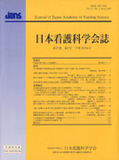Japanese
English
- 販売していません
- Abstract 文献概要
- 参考文献 Reference
- サイト内被引用 Cited by
要旨
本研究は, 指尖血流量の左右差から乳がん術後リンパ浮腫患者の生理学的特徴を明らかにし, それがリンパ浮腫発症の予測指標として成立する可能性について検討することを目的に実施した. 女性乳がん患者95人と健康な女性80人を被験者として, 血流計を用いた指尖血流量測定を実施しリンパ浮腫の有無で検討した. その結果, (1) 対象者すべてにおいて左血流量は右血流量よりも多く, (2) 一般女性と非浮腫患者の血流量および血流量差には差を認めず, (3)%血流量差は浮腫患者が非浮腫患者に比べ有意に高値だった. さらに, (4)%血流量差30.0以上でリンパ浮腫保有率が100%となり, 非浮腫患者のMean+3 SD 値は29.61を示した. また, 血流量差7ml/min/100g以上で, リンパ浮腫保有率が約9倍高くなった.
以上の結果から, 血流量差増大は浮腫患者の生理学特徴といえることが示唆されたと同時に, 血流量差がリンパ浮腫発症予測指標となり得, そのカットオフ値は, %血流量差29.61, 血流量差7m1/min/100gとできる可能性が見出された.
Abstract
This research was conducted with the goals of: determining the physiological characteristics of lymphedema patients following breast cancer surgery based on the difference between the blood flow in the right and left fingertips in order to determine whether or not this simple measurement could serve as a predictive index for the occurrence of lymphedema. A total of 95 female breast cancer patients and 80 healthy females were investigated. The fingertip blood flows in all subjects were measured using a blood flowmeter, and the existence of lymphedema was taken into consideration. The results were as follows: (1) the left blood flow was greater than right blood flow in all controls, (2) there was no disparity seen in either the blood flow or the blood flow difference, for both normal women and non-edematous patients, (3) the edematous patients showed significantly higher values than the non-edematous patients in the blood flow difference percentage value. Furthermore, (4) when the blood flow difference percentage was greater than 30.0, the lymphedema occurrence ratio became 100%, while in non-edematous patients, the mean + 3 SD value was observed to be 29.61. In addition, when the blood flow difference was more than 7 ml/min/100g, the lymphedema occurrence ratio increased approximately by 9 times.
From the above results, the increase in the blood flow difference suggested that it could be regarded as a physiological characteristic of edematous patients, in addition to which the possibility arose that the blood flow difference could be a predictive index of lymphedema occurrence, with a cutoff value represented by a blood flow difference percentage value of 29.61 and a blood flow difference of 7 ml/min/100g.
Copyright © 2007, Japan Academy of Nursing Science. All rights reserved.


